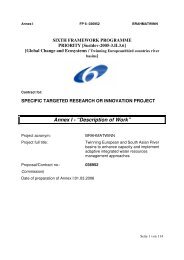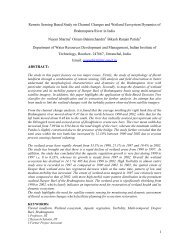WP 5 Analysis of present IWRM practices - Brahmatwinn
WP 5 Analysis of present IWRM practices - Brahmatwinn
WP 5 Analysis of present IWRM practices - Brahmatwinn
You also want an ePaper? Increase the reach of your titles
YUMPU automatically turns print PDFs into web optimized ePapers that Google loves.
are strongly regulated. On the Inn, for example, less than 20 % can still be classified as free-flowing<br />
which means not impounded or not strongly regulated (ICPCR 2004).<br />
Flood protection is based on three scopes: natural retention, structural flood protection and flood<br />
prevention. To realize this, in Bavaria a so called action plan 2020 for the Danube River Basin is made<br />
including 2.3 billion Euros. This action plan includes the restoring <strong>of</strong> floodplains as well as the<br />
reduction <strong>of</strong> sealing.<br />
Fig. 5: Effect <strong>of</strong> the Sylvenstein dam since 1959<br />
(BAYERISCHES LANDESAMT FÜR WASSERWIRTSCHAFT 2004, modified).<br />
The technical flood protection also includes local embankments along the rivers. For sustainable<br />
flood protection more activities are required: the enlargement <strong>of</strong> the river bed, artificial flood plains<br />
or the use <strong>of</strong> mobile protection elements. Furthermore future building and construction projects<br />
should not be made within flood areas.<br />
2.1.3 Risk <strong>of</strong> droughts<br />
According to the Joint Research Center <strong>of</strong> the European Commission there is no consistent European<br />
information on drought situations and their consequences, and no European coordination <strong>of</strong> alerts or<br />
mitigation activities. The reason for this is seen in the fact that droughts are developing very slowly<br />
('creeping') and their beginning and end is difficult to define (EU JOINT RESEARCH CENTER 2007).<br />
Therefore the Joint Research Center (being actively involved in the work <strong>of</strong> the ICPDR) is developing a<br />
set <strong>of</strong> droughts indicators, incorporating the impact <strong>of</strong> water stress on the natural vegetation and on<br />
agriculture. The production <strong>of</strong> a soil moisture and plant water stress map (using the so called<br />
LISFLOOD model) is also included. The LISFLOOD model has been specifically developed to simulate<br />
floods in large European drainage basins taking into account the influences <strong>of</strong> land use, spatial<br />
variations <strong>of</strong> soil properties and spatial precipitation differences. The objective is to carry out a<br />
feasibility study on drought modeling for Europe, using a test region within the Danube catchment<br />
area as an example and draw recommendations for the future development <strong>of</strong> a European Drought<br />
Alert System.<br />
9





